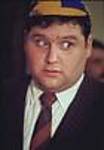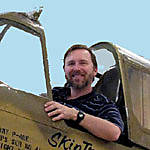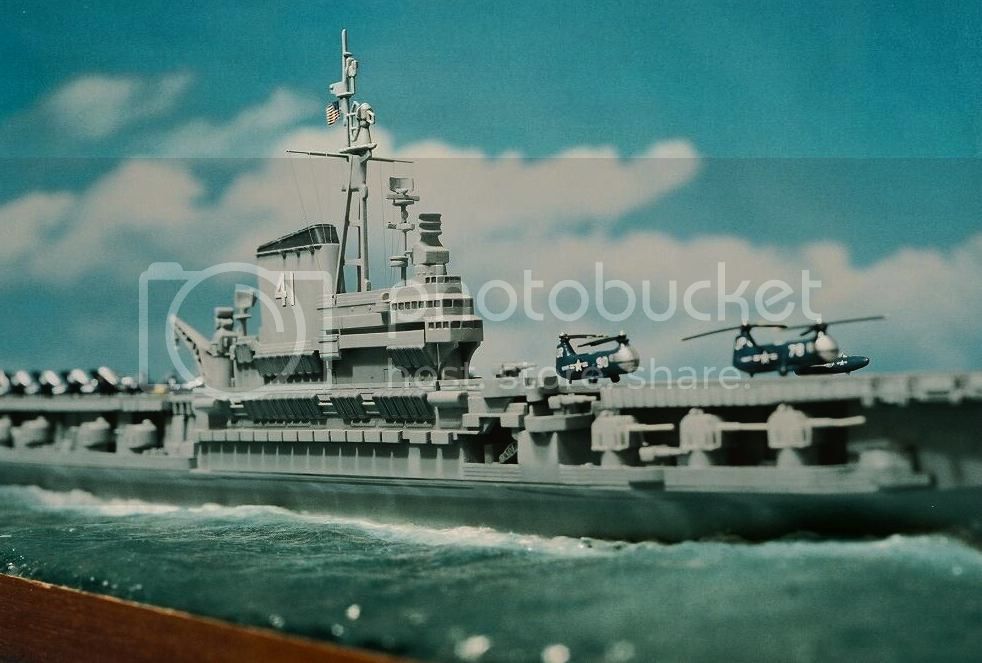You are viewing the archived version of the site.
Go to modelshipwrights.com for the current dynamic site!
Go to modelshipwrights.com for the current dynamic site!
Building Revell's USS Midway
5
Comments
"MSW crew-mate Tim Reynaga (TimReynaga) takes us on a build trip of an oldy but goody kit, Revell Models USS Midway 1/547 scale, in this MSW Build Feature!"
KIT: USS Midway 1/547 scale by Revell
Kit # H-441
PRICE: $2.49 (in 1954)
DECALS: yes
REVIEWER: Tim Reynaga
NOTES: 1974 boxing of 1954 kit
Completed too late for the Second World War, the Midway nevertheless had a busy career including annual deployments in the Atlantic and with the 6th Fleet in the Mediterranean. A hhighlight during this period was Operation Sandy in September 1947, in which she test fired a captured German V-2 rocket from her flight deck—the first such launching from a moving platform. In 1952, the angled flight deck concept was evaluated in tests conducted on a simulated angled deck aboard Midway by Naval Air Test Center and Atlantic Fleet pilots. The tests were a success, and from 1955 to 1957 the ship underwent a massive reconstruction in which she was fitted with an angled flight deck, as have all USN aircraft carriers since. In addition, the ship received an enclosed “hurricane bow”, a new deck edge elevator, steam catapults, mirror landing systems, and other modifications to allow the Midway to operate larger, heavier jet aircraft.
Following her refit the ship began annual deployments with the 7th Fleet in the Pacific. The carrier was on duty in the South China Sea during the Laotian crisis of spring l961, and during the subsequent Vietnam Conflict the Midway was among the first carriers on station. Beginning in April 1965, her aircraft flew strikes against military and logistics installations in both North and South Vietnam. During three separate deployments, 1965, 1971, and 1972, her air groups flew hundreds of sorties including airstrikes, rescues, and mining North Vietnamese harbors. Midway airmen also achieved the distinction of scoring the very first, 1965, and last, 1973, air-to-air victories of the war.
In October 1973 Midway put into Yokosuka, Japan, marking the first forward-deployment of a complete carrier battle group in a Japanese port. This prepositioning of carriers in the Far East was especially significant at a time when the fiscal cutbacks had educed the number of carriers in the fleet. Yokosuka remained Midway’s base for the next eighteen years.
In April 1975 Midway responded, along with her sister Coral Sea and three other carriers, when North Vietnamese forces finally succeeded in overrunning their neighbor to the South. In this last act of the Vietnam War, hundreds of American and Vietnamese personnel were evacuated by sea after the fall of Saigon to the Communists. In one unusual incident a South Vietnamese pilot escaped with his family to safety by landing a small civil aircraft aboard Midway. In May 1975 Midway served as a floating airfield in support of special operations forces in the rescue of the cargo ship Mayaguez which had been captured by Khmer Rouge pirates off Vietnam.
Throughout the 1970s and 1980s Midway served almost continuously as a forward deployed contingency carrier in the Western Pacific and Indian Oceans. Notable incidents during this time included a dramatic rescue of the passengers and crew of a crashed civilian helicopter in 1981 and the final carrier launching of a USN F-4 Phantom II in 1986.
In 1991, Midway had her last wartime deployment as one of the six aircraft carriers sent by the US against Saddam Hussein’s Iraq as part of Operation Desert Shield in the first Gulf War. Midway’s airgroup participated as part of Operation Imminent Thunder, a combined amphibious landing feint in northeastern Saudi Arabia which involved about 1,000 U.S. Marines, 16 warships, and more than 1,100 aircraft.
A few months after the war, the Midway was finally decommissioned. After nearly 48 years of service spanning the surrender of Japan in WWII, the Cold War, Vietnam, the era of détente and Desert Storm during which an amazing 225,000 sailors served aboard her, the ship joined the mothball fleet at Bremerton, Washington. In 2004 the Midway began the final phase of her long service as the centerpiece of the popular U.S. Navy Aircraft Carrier Museum at San Diego, California.

The kit represents the ship as she appeared not long after completion but with the original 40mm Bofors quads replaced with 3"/L50 twins. The Mk.37 directors are still fitted with the WWII-era Mk. 4 radars though, so I’m not certain of the precise date; somewhere in the early 1950s seems likely. It is definitely represents Midway before the ship’s major 1955-7 refit because of the open bow, straight flight deck, and numerous 20mm Oerlikon mounts. The kit comes with a small airgroup consisting of 16 Cougars, 6 Corsairs, 2 Skyraiders, and 2 helos.
As with most of the very earliest plastic ship kits, it is a “box scale” model—that is, scaled to fit a standard sized box on hobby shop shelves rather than to a constant scale. In this case it works out to about 1/547, an oddball size that makes swapping components from other kits or finding aftermarket upgrade parts a challenge. Another problematic aspect of this kit is that the Roosevelt/Midway/Coral Sea is one of Revell’s infamous “flat bottom boats”. In 1954 Revell had not yet decided whether their products were to be marketed as accurate scale models or as children’s toys, so they compromised and made the hulls mostly accurate but with flat bottoms so kids could play with them on the floor. Some of the plastic ship models of this time even had tiny wheels to make this easier! While appealing to kids (I remember preferring these to the rounded hull models that tended to roll over during combat ops in the back yard), they made these kits totally inaccurate as full hull models. Too bad, because the Midway’s hull above the waterline is pretty decent.
While I’m not nuts about the molded-to-the-deck solid railings and molded-in 20mm guns, the shapes and dimensions above the waterline are accurate and convincingly rendered. And although it is sometimes somewhat heavy, there is quite a bit of detail. The 3” twins and 5"/L54 mk 39 guns are covered in details which, if overdone, at least add interest. The island sports both open and closed doors, sharply incised bridge windows, life rafts, and flag bags. The hull and sponsons are festooned with numerous molded in shapes which impart a general impression of complexity while using only a few parts. On the flight deck I was impressed with the sharply molded catapult tracks, arrestor gear, accurately ribbed gallery sides… even hundreds of tiny raised dots representing aircraft tie down points. There are also a number of very delicately sculpted smaller details like floater net baskets (with floats visible inside), deck winches, cranes, and some excellent canvas cover detail on the two lifeboats aft. These well done touches may be from the hand of the primary pattern maker for the kit, Anthony D. Bulone, a talented sculptor best known as the creator of the face for the original Mattel Barbie doll.
KIT: USS Midway 1/547 scale by Revell
Kit # H-441
PRICE: $2.49 (in 1954)
DECALS: yes
REVIEWER: Tim Reynaga
NOTES: 1974 boxing of 1954 kit
HISTORY

Completed too late for the Second World War, the Midway nevertheless had a busy career including annual deployments in the Atlantic and with the 6th Fleet in the Mediterranean. A hhighlight during this period was Operation Sandy in September 1947, in which she test fired a captured German V-2 rocket from her flight deck—the first such launching from a moving platform. In 1952, the angled flight deck concept was evaluated in tests conducted on a simulated angled deck aboard Midway by Naval Air Test Center and Atlantic Fleet pilots. The tests were a success, and from 1955 to 1957 the ship underwent a massive reconstruction in which she was fitted with an angled flight deck, as have all USN aircraft carriers since. In addition, the ship received an enclosed “hurricane bow”, a new deck edge elevator, steam catapults, mirror landing systems, and other modifications to allow the Midway to operate larger, heavier jet aircraft.
Following her refit the ship began annual deployments with the 7th Fleet in the Pacific. The carrier was on duty in the South China Sea during the Laotian crisis of spring l961, and during the subsequent Vietnam Conflict the Midway was among the first carriers on station. Beginning in April 1965, her aircraft flew strikes against military and logistics installations in both North and South Vietnam. During three separate deployments, 1965, 1971, and 1972, her air groups flew hundreds of sorties including airstrikes, rescues, and mining North Vietnamese harbors. Midway airmen also achieved the distinction of scoring the very first, 1965, and last, 1973, air-to-air victories of the war.
In October 1973 Midway put into Yokosuka, Japan, marking the first forward-deployment of a complete carrier battle group in a Japanese port. This prepositioning of carriers in the Far East was especially significant at a time when the fiscal cutbacks had educed the number of carriers in the fleet. Yokosuka remained Midway’s base for the next eighteen years.
In April 1975 Midway responded, along with her sister Coral Sea and three other carriers, when North Vietnamese forces finally succeeded in overrunning their neighbor to the South. In this last act of the Vietnam War, hundreds of American and Vietnamese personnel were evacuated by sea after the fall of Saigon to the Communists. In one unusual incident a South Vietnamese pilot escaped with his family to safety by landing a small civil aircraft aboard Midway. In May 1975 Midway served as a floating airfield in support of special operations forces in the rescue of the cargo ship Mayaguez which had been captured by Khmer Rouge pirates off Vietnam.
Throughout the 1970s and 1980s Midway served almost continuously as a forward deployed contingency carrier in the Western Pacific and Indian Oceans. Notable incidents during this time included a dramatic rescue of the passengers and crew of a crashed civilian helicopter in 1981 and the final carrier launching of a USN F-4 Phantom II in 1986.
In 1991, Midway had her last wartime deployment as one of the six aircraft carriers sent by the US against Saddam Hussein’s Iraq as part of Operation Desert Shield in the first Gulf War. Midway’s airgroup participated as part of Operation Imminent Thunder, a combined amphibious landing feint in northeastern Saudi Arabia which involved about 1,000 U.S. Marines, 16 warships, and more than 1,100 aircraft.
A few months after the war, the Midway was finally decommissioned. After nearly 48 years of service spanning the surrender of Japan in WWII, the Cold War, Vietnam, the era of détente and Desert Storm during which an amazing 225,000 sailors served aboard her, the ship joined the mothball fleet at Bremerton, Washington. In 2004 the Midway began the final phase of her long service as the centerpiece of the popular U.S. Navy Aircraft Carrier Museum at San Diego, California.
THE KIT
This kit is one of the early polystyrene plastic model ship kits, appearing just a year after the granddaddy of them all, Revell’s 1/535 scale Missouri. Initially issued in 1954 as the Franklin D. Roosevelt (kit H-307), it was Revell’s first aircraft carrier and their largest plastic model kit to date—and it sold for a mere $2.49! That kit was identical to the numerous re-releases over the years, except that it had the number “42” in raised outline on both sides of the funnel and on the flight deck fore and aft. It was next issued as a part of the 1955 “Victory at Sea” set, followed by a Picture Fleet kit circa 1960 (H-321) along with a Midway (kit H-373) and a motorized Coral Sea (H-399). The Coral Sea appeared again without the motor in 1966 (H-374), and once again in 1974 with new box art (H-440) along with the Midway (H-441). Other than the raised numbering (deleted from all but the earliest issues) and the motor on the 1961 Coral Sea, the only differences among these kits were the box illustrations, decals, and instructions. With this dizzying array of re-releases over the years, Revell sure seems to have got their money’s worth out of this one!The kit represents the ship as she appeared not long after completion but with the original 40mm Bofors quads replaced with 3"/L50 twins. The Mk.37 directors are still fitted with the WWII-era Mk. 4 radars though, so I’m not certain of the precise date; somewhere in the early 1950s seems likely. It is definitely represents Midway before the ship’s major 1955-7 refit because of the open bow, straight flight deck, and numerous 20mm Oerlikon mounts. The kit comes with a small airgroup consisting of 16 Cougars, 6 Corsairs, 2 Skyraiders, and 2 helos.
As with most of the very earliest plastic ship kits, it is a “box scale” model—that is, scaled to fit a standard sized box on hobby shop shelves rather than to a constant scale. In this case it works out to about 1/547, an oddball size that makes swapping components from other kits or finding aftermarket upgrade parts a challenge. Another problematic aspect of this kit is that the Roosevelt/Midway/Coral Sea is one of Revell’s infamous “flat bottom boats”. In 1954 Revell had not yet decided whether their products were to be marketed as accurate scale models or as children’s toys, so they compromised and made the hulls mostly accurate but with flat bottoms so kids could play with them on the floor. Some of the plastic ship models of this time even had tiny wheels to make this easier! While appealing to kids (I remember preferring these to the rounded hull models that tended to roll over during combat ops in the back yard), they made these kits totally inaccurate as full hull models. Too bad, because the Midway’s hull above the waterline is pretty decent.
While I’m not nuts about the molded-to-the-deck solid railings and molded-in 20mm guns, the shapes and dimensions above the waterline are accurate and convincingly rendered. And although it is sometimes somewhat heavy, there is quite a bit of detail. The 3” twins and 5"/L54 mk 39 guns are covered in details which, if overdone, at least add interest. The island sports both open and closed doors, sharply incised bridge windows, life rafts, and flag bags. The hull and sponsons are festooned with numerous molded in shapes which impart a general impression of complexity while using only a few parts. On the flight deck I was impressed with the sharply molded catapult tracks, arrestor gear, accurately ribbed gallery sides… even hundreds of tiny raised dots representing aircraft tie down points. There are also a number of very delicately sculpted smaller details like floater net baskets (with floats visible inside), deck winches, cranes, and some excellent canvas cover detail on the two lifeboats aft. These well done touches may be from the hand of the primary pattern maker for the kit, Anthony D. Bulone, a talented sculptor best known as the creator of the face for the original Mattel Barbie doll.
Comments
An excellent presentation on both the ship and a classic kit!
The layout of the kit represents the Midway between 1946 and 1952. The original armored pilothouse was actually chopped off and the island forward of the funnel was completely replaced and the part of the flight deck that overhung the forecastle was actually cut back to produce an odd 'semi-hurricane bow'. In effect, the forward 3"-50's were left exposed but the rest of the forecastle was walled off, leaving secondary conn as a projecting bay-window. I recommend Pete Clayton's book on the Midway as an essential reference.
An interesting note about the flight deck colors: she was the first U. S. carrier to have an armored deck, so the steel was painted a dark deck gray, but then it was surmounted by thousands of black adhesive non-skid pads. These pads just touched one another end-to-end but were separated by 2-3 inches on the sides, producing a strange courderoy effect. How to paint that in 1/547 will be a challenge....perhaps decal film would work?
One advantage to working on the Midway is that you can still see vestiges of the ship's earlier layouts, especially on the hangar and flight deck levels. A 1:350 series on the Midways would be a welcome addition to the hobby.
--Karl
MAY 14, 2009 - 05:48 AM
Tim, great job! Brings back memories. Aside from the 3 inch twins, it would be make you look twice to tell it from some of the new models from the 1990s. And you are right about the aircraft - 1/350 planes made with a zillion parts, these old Revell skysteeds look pretty good when painted and decaled as well as you did. Salute!
JAN 30, 2015 - 07:08 PM
Copyright ©2021 by Tim Reynaga. _OPINIONS Model Shipwrights, KitMaker Network, or Silver Star Enterrpises. Images also by copyright holder unless otherwise noted. Opinions expressed are those of the author(s) and not necessarily those of Model Shipwrights. All rights reserved. Originally published on: 2009-05-14 00:00:00. Unique Reads: 22868










